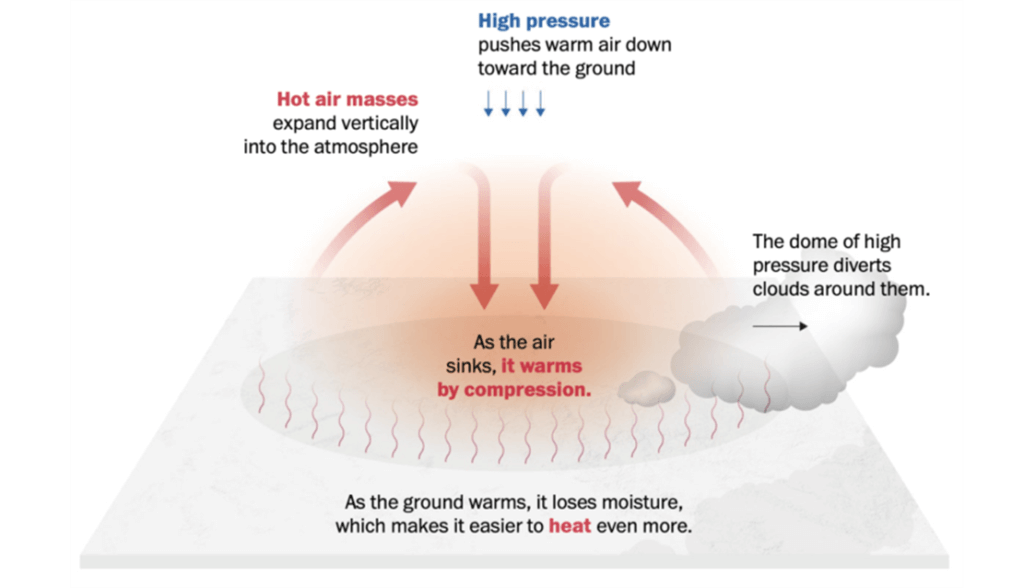The heat dome over North-West India, which has been causing record-breaking temperatures and health hazards, may be retracting soon, according to recent reports. A heat dome is a weather phenomenon that occurs when the atmosphere traps hot ocean air like a lid or cap, leading to extreme heat waves that get trapped under a high-pressure “dome.” Heat domes can have severe impacts on people and the environment, and their occurrence and intensity may be linked to climate change.
Formation and Correlation with Jet Streams
A heat dome forms when strong, high-pressure atmospheric conditions combine with influences from La Niña, a cyclical cooling of the equatorial Pacific Ocean that can affect weather patterns around the world.
Typically, heat domes are tied to the behavior of the jet stream, a band of fast winds high in the atmosphere that generally runs west to east. Normally, the jet stream has a wavelike pattern, meandering north and then south and then north again. When these meanders become bigger, they move slower and can become stationary. That’s when heat domes can occur.
Impacts on People
- A heat dome can have severe impacts on people.
- Stagnant weather patterns allow it to exist, which results in weak winds and an increase in humidity.
- These factors make the heat feel worse and become more dangerous.
- The human body is not cooled as much by sweating in a heat dome.
- The high humidity also reduces the amount of cooling at night.
- Warm nights can leave people without air conditioners unable to cool off.
- This increases the risk of heat illnesses and deaths.
- One of the worst examples of the impacts from a heat dome with high temperatures and humidity in the U.S. occurred in the summer of 1995.
- An estimated 739 people died in the Chicago area over five days.
Heat Waves
A heat wave is a period of unusually hot weather that lasts for more than two days. Heat waves can occur with or without high humidity and have the potential to cover a large area, exposing a high number of people to hazardous heat. Heat waves can also affect ecosystems, agriculture, energy demand, and air quality. In recent years, many regions of the world have experienced more frequent and severe heat waves, which may be linked to climate change.
Climate Change and Extreme Heat
- Scientists believe that heat waves today are more likely to be a result of climate change caused by humans.
- A small increase in the Earth’s average temperature can dramatically impact climate extremes.
- Extreme heat events are occurring more frequently and with more severity.
- They will likely push the average temperatures higher for years to come.
- If greenhouse gas emissions are not significantly reduced, the coldest and warmest daily temperatures will increase.
- They are expected to increase by at least 5 degrees F in most areas by mid-century.
- They are expected to rise to 10 degrees F by the late century.

Why In News
According to recent reports, the ‘Heat dome’ over North-West India, which has been causing extreme temperatures and posing a severe threat to public health, may finally be retracting. If the heat dome subsides, it will bring much-needed relief to the region, allowing people to recover from the heat stress and minimize the risk of heat-related illnesses.
MCQs on The Potential Retraction of the Heat Dome over North-West India
-
What is a heat dome?
a. A type of storm system
b. A weather pattern that traps hot air under high pressure
c. A cooling mechanism for the atmosphere
d. A geographic region known for its hot climate
-
How does a heat dome impact human health?
a. By increasing wind speeds and decreasing humidity levels
b. By reducing the risk of heat illnesses and deaths
c. By increasing humidity levels and reducing the body’s ability to cool down
d. By causing cold-related illnesses and deaths
-
What is the correlation between a heat dome and the jet stream?
a. Heat domes are caused by the behavior of the jet stream
b. Heat domes have no correlation with the jet stream
c. Heat domes weaken the jet stream
d. Heat domes strengthen the jet stream
-
Why are scientists concerned about the increase in extreme heat events?
a. Because they make outdoor activities more enjoyable
b. Because they lead to decreased energy consumption
c. Because they are a result of climate change caused by human activities
d. Because they have no impact on human health
Boost up your confidence by appearing our Weekly Current Affairs Multiple Choice Questions
![]()


